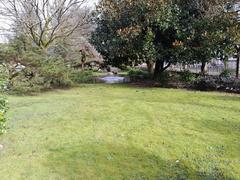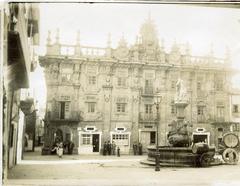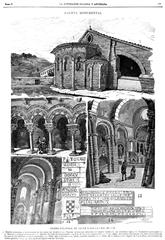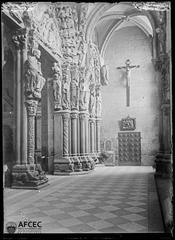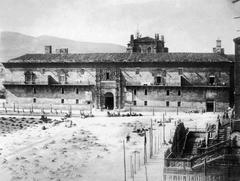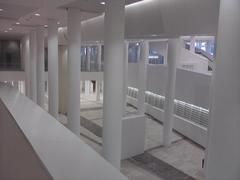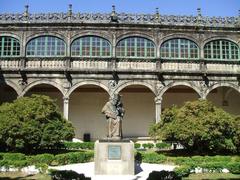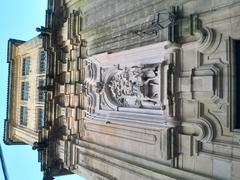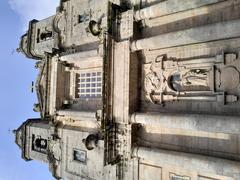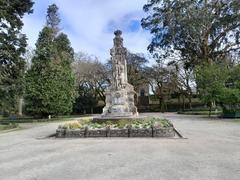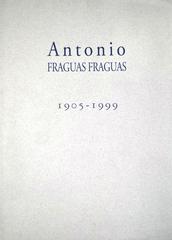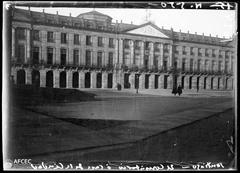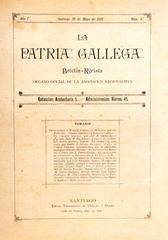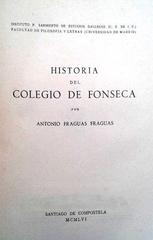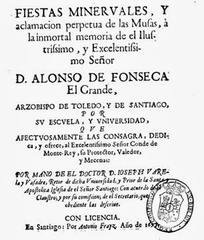Pazo do Espiño: A Complete Visitor’s Guide to Santiago de Compostela’s Art Nouveau Manor and Park
Date: 04/07/2025
Introduction
Pazo do Espiño stands as a unique architectural and cultural landmark in Santiago de Compostela, offering visitors a rare encounter with Galician Art Nouveau set amidst lush botanical gardens. Located just a short walk from the Cathedral and Plaza del Obradoiro, it serves as both a historical monument and a tranquil green space for locals, pilgrims, and tourists. This guide provides a comprehensive overview—covering history, architecture, conservation, practical visitor information, accessibility, and tips—ensuring you make the most of your visit to this remarkable site (Art-Nouveau Coruña; Wikipedia).
Table of Contents
- Historical & Architectural Overview
- Botanical and Natural Highlights
- Visitor Information
- Nearby Attractions
- FAQ
- Conclusion and Recommendations
- References
Historical & Architectural Overview
Origins and Construction
Pazo do Espiño was commissioned by Ramón Gutiérrez de la Peña Quiroga, a prominent lawyer and politician, and constructed between 1910 and 1915. Its architect, Jesús López de Rego Labarta, introduced the Art Nouveau style to the Galician pazo tradition, creating a structure that blends regional identity with early 20th-century innovation (Art-Nouveau Coruña; Wikipedia).
Art Nouveau Significance
Unlike the typical granite-built Galician manor houses, Pazo do Espiño’s structure features cement and iron, enabling elaborate decorative motifs—vegetal patterns, gargoyles, and battened cornices—characteristic of Art Nouveau. The estate comprises two main floors, a private chapel, and an irregular layout, all set within a walled park (Art-Nouveau Coruña).
Decline and Conservation
Over time, Galicia’s humid climate and the experimental use of concrete led to the manor’s deterioration. By the early 21st century, the building was in ruin. Restoration efforts stabilized the structure and, in 2014, the surrounding park was opened to the public. The main building remains closed, but ongoing projects aim to preserve the historic ruin while integrating new community spaces (Galicia Máxica; Fundación Jacobea).
Botanical and Natural Highlights
Ancient and Rare Trees
A standout feature of the park is its century-old oak grove (carballeira), with over 250 mature oaks providing habitat and shade. The park also boasts camellias over 80 years old, rare specimens like Norway spruce and araucaria, chestnuts, magnolias, and hollies, all contributing to a rich botanical tapestry (Santiago Turismo; I Love Compostela).
Gardens and Biodiversity
Landscaped gardens, fruit tree orchards, meadows, and pastures create a mosaic of habitats supporting diverse plant and animal life. The careful preservation of these natural elements enhances both ecological value and visitor experience (Fundación Jacobea).
Water Features and Sustainability
A lagoon area recycles rainwater for irrigation, supporting lush vegetation and attracting local wildlife. This sustainable design is part of Santiago’s broader green initiative, transforming former private estates into accessible public parks (Santiago Turismo).
Visitor Information
Opening Hours and Tickets
- Summer (April–September): 8:00–23:00
- Winter (October–March): 8:00–20:00
- Admission: Free; no tickets required (Santiago Turismo).
The park is open every day of the year. The building itself remains closed for safety and conservation.
Accessibility
- Main paths are step-free and suitable for wheelchairs and strollers.
- Some terrain near the lagoon and ruins may be uneven.
- Clearly marked signage guides visitors throughout the park (I Love Compostela).
Facilities and Tips
- Picnic Areas: Benches and stone tables are scattered throughout, offering scenic views.
- Restrooms: Public toilets are available at the main entrance and maintained daily.
- Pets: Dogs are welcome but must be leashed; owners must clean up after their pets.
- No Onsite Cafés: Nearby Galeras neighborhood offers refreshments.
- Safety: Park is patrolled by municipal staff; cyclists must stay on designated paths.
Getting There
- Walking: Less than 10 minutes from the Cathedral and Old Town.
- Public Transport: Local bus lines (e.g., L10, L11) serve the Galeras area.
- Parking: Limited street parking nearby; walking is recommended (Nomads Travel Guide).
Events and Community
- Occasional guided tours and educational events are offered, especially during festivals.
- The park hosts open-air concerts and cultural activities in summer.
- Check Santiago Turismo or local listings for current schedules.
Nearby Attractions
- Cathedral of Santiago de Compostela – UNESCO World Heritage site.
- Historic Old Town – Markets, tapas bars, and museums.
- Parque de Galeras – Adjacent park with additional trails.
- Monte Pío – Scenic viewpoint.
- Sarela River Promenade – Riverside walk linking city green spaces.
FAQ
Q: Is there a fee to enter Pazo do Espiño Park?
A: No, entry is free for all visitors.
Q: Can I visit the interior of the manor house?
A: No, the building is closed due to its fragile condition.
Q: Are pets allowed?
A: Yes, dogs are permitted on a leash.
Q: Are there guided tours?
A: Not regularly, but special events and tours are sometimes offered.
Q: Is the park accessible for people with limited mobility?
A: Most main paths are accessible, though some areas are uneven.
Q: What are the best times to visit?
A: Spring and autumn for mild weather and blooming gardens.
Conclusion and Recommendations
Pazo do Espiño is a must-visit destination in Santiago de Compostela, seamlessly blending Art Nouveau heritage, serene gardens, and panoramic city views. The park’s free admission, accessible paths, and family-friendly amenities make it ideal for locals, pilgrims, and tourists alike. While the manor itself remains a poignant ruin, the surrounding park offers a vibrant green escape and a window into Santiago’s evolving cultural landscape.
Plan your visit by checking Santiago Turismo, download the Audiala app for audio guides and real-time updates, and respect conservation efforts while enjoying this exceptional site.
References
- Art-Nouveau Coruña – Pazo do Espiño
- Wikipedia – Pazo do Espiño
- Galicia Máxica – Pazo do Espiño Ruins
- Fundación Jacobea – Parque de Galeras y la Finca do Espiño
- Santiago Turismo – Parque de la Finca do Espiño
- I Love Compostela – Finca do Espiño Park
- Nomads Travel Guide – Santiago de Compostela
